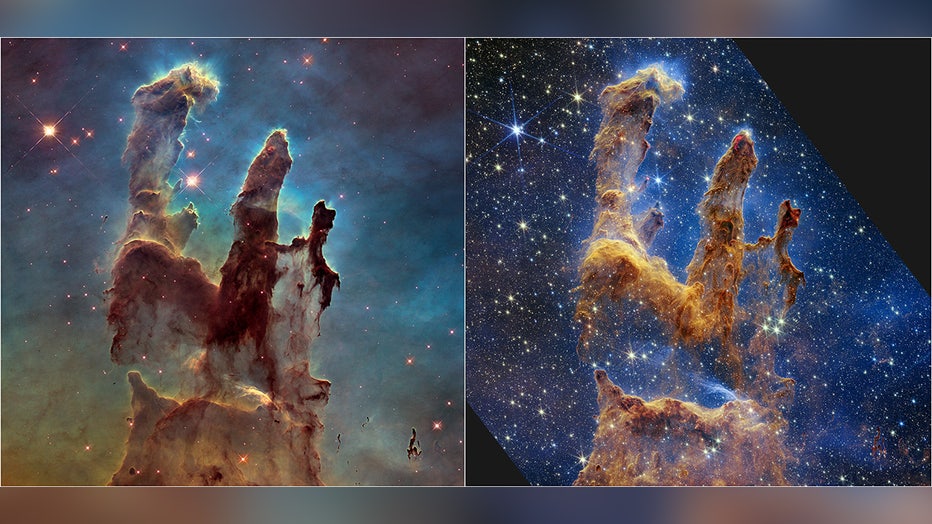James Webb telescope captures stunning photo revealing ‘kaleidoscope of color’ in Pillars of Creation
The Pillars of Creation are set off in a kaleidoscope of color in the NASA/ESA/CSA James Webb Space Telescope’s near-infrared-light view, NASA says. (NASA, ESA, CSA, STScI; J. DePasquale, A. Koekemoer, A. Pagan (STScI) )
NASA’s James Webb Space Telescope has provided a new detailed look at the Pillars of Creation that shows the scene in high definition.
The new Near-Infrared Camera (NIRCam) image shows the lush landscape with glowing, bright red, wavy lines appearing at the edges of some pillars.
JAMES WEBB SPACE TELESCOPE IMAGES WOW BY SHOWING STAR NURSERY, GALAXIES IN A COSMIC DANCE
"The three-dimensional pillars look like majestic rock formations but are far more permeable," NASA said, "These columns are made up of cool interstellar gas and dust that appear – at times – semi-transparent in near-infrared light."
The Pillars of Creation are a region where young stars are forming and lie 6,500 light-years away.
NASA also says that while it may look like it, there are no galaxies within this view. Instead, a "mix of translucent gas and dust known as the interstellar medium in the densest part of our Milky Way galaxy’s disk blocks our view of the deeper universe."

NASA's Hubble Space Telescope made the Pillars of Creation famous with its first image in 1995, but revisited the scene in 2014 to reveal a sharper, wider view in visible light, shown above at left. (NASA, ESA, CSA, STScI; Joseph DePasquale (STScI), Anton M. Koekemoer (STScI), Alyssa Pagan (STScI))
JAMES WEBB SPACE TELESCOPE CAPTURES JUPITER'S SWIRLING WEATHER, COLORFUL AURORAS AND RINGS
‘New’ stars steal the show
The detailed look also shows where new stars form within the dense clouds of gas and dust.
The young stars are believed to be a few hundred thousand years old.
Scientists say that the bright red orbs are newly formed stars that have burst into view, and a translucent layer of gas and dust is drawn like a curtain, allowing the stars to take center stage.
STAR DUO CREATES A 'FINGERPRINT' IN SPACE CAPTURED BY JAMES WEBB SPACE TELESCOPE
"Young stars periodically shoot out supersonic jets that collide with clouds of material, like these thick pillars. This sometimes also results in bow shocks, which can form wavy patterns like a boat does as it moves through water," NASA explains. "The crimson glow comes from the energetic hydrogen molecules that result from jets and shocks. This is evident in the second and third pillars from the top – the NIRCam image is practically pulsing with their activity."
The Hubble Space Telescope first captured the Pillars of Creation on April 1, 1995. With Webb’s newest near-infrared image of the Pillars of Creation, researchers will continue to understand star formation. Scientists hope that they’ll learn how stars form and burst out of these dusty clouds over millions of years.

